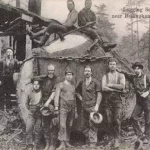 | |
Paul Bunyan | |
| Author | W.B. Laughead |
|---|---|
| Published |
1922
|
| Language | English |
| Nationality | American |
| Genre | Advertising Slogans, Poetry |
1922 Short Story
Paul Bunyan
Paul Bunyan is an English Advertising Slogans, Poetry short story by American writer W.B. Laughead. It was first published in 1922.
Paul Bunyan
by W.B. Laughead
Scholars Say He is the Only American Myth.
Paul Bunyan is the hero of lumbercamp whoppers that have been handed down for generations. These stories, never heard outside the haunts of the lumberjack until recent years, are now being collected by learned educators and literary authorities who declare that Paul Bunyan is “the only American myth.”
The best authorities never recounted Paul Bunyan’s exploits in narrative form. They made their statements more impressive by dropping them casually, in an off hand way, as if in reference to actual events of common knowledge. To overawe the greenhorn in the bunkshanty, or the paper-collar stiffs and home guards in the saloons, a group of lumberjacks would remember meeting each other in the camps of Paul Bunyan. With painful accuracy they established the exact time and place, “on the Big Onion the winter of the blue snow” or “at Shot Gunderson’s camp on the Tadpole the year of the sourdough drive.” They elaborated on the old themes and new stories were born in lying contests where the heights of extemporaneous invention were reached.
In these conversations the lumberjack often took on the mannerisms of the French Canadian. This was apparently done without special intent and no reason for it can be given except for a similarity in the mock seriousness of their statements and the anti-climax of the bulls that were made, with the braggadocio of the habitant. Some investigators trace the origin of Paul Bunyan to Eastern Canada. Who can say?
Paul Bunyan came to Westwood, California, in 1913 at the suggestion of some of the most prominent loggers and lumbermen in the country. When the Red River Lumber Company announced their plans for opening up their forests of Sugar Pine and California White Pine, friendly advisors shook their heads and said,
“Better send for Paul Bunyan.”
Apparently here was the job for a Superman,quality-and-quantity-production on a big scale and great engineering difficulties to be overcome. Why not Paul Bunyan? This is a White Pine job and here in the High Sierras the winter snows lie deep, just like the country where Paul grew up. Here are trees that dwarf the largest “cork pine” of the Lake States and many new stunts were planned for logging, milling and manufacturing a product of supreme qualityjust the job for Paul Bunyan.
The Red River people had been cutting White Pine in Minnesota for two generations; the crews that came west with them were old heads and every one knew Paul Bunyan of old. Paul had followed the White Pine from the Atlantic seaboard west to the jumping-off place in Minnesota, why not go the rest of the way?
Paul Bunyan’s picture had never been published until he joined Red River and this likeness, first issued in 1914 is now the Red River trademark. It stands for the quality and service you have the right to expect from Paul Bunyan.
***** When and where did this mythical Hero get his start? Paul Bunyan is known by his mighty works, his antecedents and personal history are lost in doubt. You can prove that Paul logged off North Dakota and grubbed the stumps, not only by the fact that there are no traces of pine forests in that State, but by the testimony of oldtimers who saw it done. On the other hand, Paul’s parentage and birth date are unknown. Like Topsy, he jes’ growed.
Nobody cared to know his origin until the professors got after him. As long as he stayed around the camps his previous history was treated with the customary consideration and he was asked no questions, but when he broke into college it was all off. Then he had to have ancestors, a birthday and all sorts of vital statistics.
Now Paul is a regular myth and students of folklore make scientific research of “The Paul Bunyan Legend”.
His first appearance in print was in the booklets published by The Red River Lumber Company in 1914 and 1916, these stories are reprinted in the present volume, with additions. Paul has followed the wanderings of pioneering workmen and performed new wonders in the oil fields, on big construction jobs and in the wheat fields but the stories in this book deal only with his work in the White Pine camps where he was born and raised. Care has been taken to preserve the atmosphere of the old style camps.
So now we will get on with Paul’s doings and in the language of the four-horse skinner, “Let’s dangle!”
Babe, the big blue ox constituted Paul Bunyan’s assets and liabilities. History disagrees as to when, where and how Paul first acquired this bovine locomotive but his subsequent record is reliably established. Babe could pull anything that had two ends to it.
Babe was seven axehandles wide between the eyes according to some authorities; others equally dependable say forty-two axehandles and a plug of tobacco. Like other historical contradictions this comes from using different standards. Seven of Paul’s axehandles were equal to a little more than forty-two of the ordinary kind.
When cost sheets were figured on Babe, Johnny Inkslinger found that upkeep and overhead were expensive but the charges for operation and depreciation were low and the efficiency was very high. How else could Paul have hauled logs to the landing a whole section (640 acres) at a time? He also used Babe to pull the kinks out of the crooked logging roads and it was on a job of this kind that Babe pulled a chain of three-inch links out into a straight bar.
They could never keep Babe more than one night at a camp for he would eat in one day all the feed one crew could tote to camp in a year. For a snack between meals he would eat fifty bales of hay, wire and all and six men with picaroons were kept busy picking the wire out of his teeth. Babe was a great pet and very docile as a general thing but he seemed to have a sense of humor and frequently got into mischief, He would sneak up behind a drive and drink all the water out of the river, leaving the logs high and dry. It was impossible to build an ox-sling big enough to hoist Babe off the ground for shoeing, but after they logged off Dakota there was room for Babe to lie down for this operation.
Once in a while Babe would run away and be gone all day roaming all over the Northwestern country. His tracks were so far apart that it was impossible to follow him and so deep that a man falling into one could only be hauled out with difficulty and a long rope. Once a settler and his wife and baby fell into one of these tracks and the son got out when he was fifty-seven years old and reported the accident. These tracks, today form the thousands of lakes in the “Land of the Sky-Blue Water.”
Because he was so much younger than Babe and was brought to camp when a small calf, Benny was always called the Little Blue Ox although he was quite a chunk of an animal. Benny could not, or rather, would not haul as much as Babe nor was he as tractable but he could eat more.
Paul got Benny for nothing from a farmer near Bangor, Maine. There was not enough milk for the little fellow so he had to be weaned when three days old. The farmer only had forty acres of hay and by the time Benny was a week old he had to dispose of him for lack of food. The calf was undernourished and only weighed two tons when Paul got him. Paul drove from Bangor out to his headquarters camp near Devil’s Lake, North Dakota that night and led Benny behind the sleigh. Western air agreed with the little calf and every time Paul looked back at him he was two feet taller.
When they arrived at camp Benny was given a good feed of buffalo milk and flapjacks and put into a barn by himself. Next morning the barn was gone. Later it was discovered on Benny’s back as he scampered over the clearings. He had outgrown his barn in one night.
Benny was very notional and would never pull a load unless there was snow on the ground so after the spring thaws they had to white wash the logging roads to fool him.
Gluttony killed Benny. He had a mania for pancakes and one cook crew of two hundred men was kept busy making cakes for him. One night he pawed and bellowed and threshed his tail about till the wind of it blew down what pine Paul had left standing in Dakota. At breakfast time he broke loose, tore down the cook shanty and began bolting pancakes. In his greed he swallowed the red-hot stove. Indigestion set in and nothing could save him. What disposition was made of his body is a matter of dispute. One oldtimer claims that the outfit he works for bought a hind quarter of the carcass in 1857 and made corned beef of it. He thinks they have several carloads of it, left.
Another authority states that the body of Benny was dragged to a safe distance from the North Dakota camp and buried. When the earth was shoveled back it made a mound that formed the Black Hills in South Dakota.
***** The custodian and chaperon of Babe, the Big Blue Ox, was Brimstone Bill. He knew all the tricks of that frisky giant before they happened.
“I know oxen,” the old bullwhacker used to say, “I’ve worked ’em and fed ’em and doctored ’em ever since the ox was invented. And Babe, I know that pernicious old reptyle same as if I’d abeen through him with a lantern.”
Bill compiled “The Skinner’s Dictionary,” a hand book for teamsters, and most of the terms used in directing draft animals (except mules) originated with him. His early religious training accounts for the fact that the technical language of the teamster contains so many names of places and people spoken of in the Bible.
The buckskin harness used on Babe and Benny when the weather was rainy was made by Brimstone Bill. When this harness got wet it would stretch so much that the oxen could travel clear to the landing and the load would not move from the skidway in the woods. Brimstone would fasten the harness with an anchor Big Ole made for him and when the sun came out and the harness shrunk the load would be pulled to the landing while Bill and the oxen were busy at some other job.
The winter of the Blue Snow, the Pacific Ocean froze over and Bill kept the oxen busy hauling regular white snow over from China. M. H. Keenan can testify to the truth of this as he worked for Paul on the Big Onion that winter. It must have been about this time that Bill made the first ox yokes out of cranberry wood.
Feeding Paul Bunyan’s crews was a complicated job. At no two camps were conditions the same. The winter he logged off North Dakota he had 300 cooks making pancakes for the Seven Axemen and the little Chore-boy. At headquarters on the Big Onion he had one cook and 462 cookees feeding a crew so big that Paul himself never knew within several hundred either way, how many men he had.
At Big Onion camp there was a lot of mechanical equipment and the trouble was a man who could handle the machinery cooked just like a machinist too. One cook got lost between the flour bin and the root cellar and nearly starved to death before he was found.
Cooks came and went. Some were good and others just able to get by. Paul never kept a poor one, very long. There was one jigger who seemed to have learned to do nothing but boil. He made soup out of everything and did most of his work with a dipper. When the big tote-sled broke through the ice on Bull Frog Lake with a load of split peas, he served warmed up, lake water till the crew struck. His idea of a lunch box was a jug or a rope to freeze soup onto like a candle. Some cooks used too much grease. It was said of one of these that he had to wear calked shoes to keep from sliding out of the cook-shanty and rub sand on his hands when he picked anything up.
There are two kinds of camp cooks, the Baking Powder Bums and the Sourdough Stiffs. Sourdough Sam belonged to the latter school. He made everything but coffee out of Sourdough. He had only one arm and one leg, the other members having been lost when his sourdough barrel blew up. Sam officiated at Tadpole River headquarters, the winter Shot Gunderson took charge.
After all others had failed at Big Onion camp, Paul hired his cousin Big Joe who came from three weeks below Quebec. This boy sure put a mean scald on the chuck. He was the only man who could make pancakes fast enough to feed the crew. He had Big Ole, the blacksmith, make him a griddle that was so big you couldn’t see across it when the steam was thick. The batter, stirred in drums like concrete mixers was poured on with cranes and spouts. The griddle was greased by colored boys who skated over the surface with hams tied to their feet. They had to have colored boys to stand the heat.
At this camp the flunkeys wore roller skates and an idea of the size of the tables is gained from the fact that they distributed the pepper with four-horse teams.
Sending out lunch and timing the meals was rendered difficult by the size of the works which required three crewsone going to work, one on the job and one coming back. Joe had to start the bull-cook out with the lunch sled two weeks ahead of dinner time. To call the men who came in at noon was another problem. Big Ole made a dinner horn so big that no one could blow it but Big Joe or Paul himself. The first time Joe blew it be blew down ten acres of pine. The Red River people wouldn’t stand for that so the next time he blew straight up but this caused severe cyclones and storms at sea so Paul had to junk the horn and ship it East where later it was made into a tin roof for a big Union Depot.
When Big Joe came to Westwood with Paul, he started something. About that time you may have read in the papers about a volcanic eruption at Mt. Lassen, heretofore extinct for many years. That was where Big Joe dug his bean-hole and when the steam worked out of the bean kettle and up through the ground, everyone thought the old hill had turned volcano. Every time Joe drops a biscuit they talk of earthquakes.
It was always thought that the quality of the food at Paul’s Camps had a lot to do with the strength and endurance of the men. No doubt it did, but they were a husky lot to start with. As the feller said about fish for a brain food, “It won’t do you no good unless there is a germ there to start with.”
There must have been something to the food theory for the chipmunks that ate the prune pits got so big they killed all the wolves and years later the settlers shot them for tigers.
A visitor at one of Paul’s camps was astonished to see a crew of men unloading four-horse logging sleds at the cook-shanty. They appeared to be rolling logs into a trap door from which poured clouds of steam.
“That’s a heck of a place to land logs,” he remarked.
“Them ain’t logs,” grinned a bull-cook, “them’s sausages for the teamsters’ breakfast.”
At Paul’s camp up where the little Gimlet empties into the Big Auger, newcomers used to kick because they were never served beans. The bosses and the men could never be interested in beans. E. E. Terrill tells us the reason:
Once when the cook quit they had to detail a substitute to the job temporarily. There was one man who was no good anywhere. He had failed at every job. Chris Crosshaul, the foreman, acting on the theory that every man is good somewhere, figured that this guy must be a cook, for it was the only job he had not tried. So he was put to work and the first thing he tackled was beans. He filled up a big kettle with beans and added some water. When the heat took hold the beans swelled up till they lifted off the roof and bulged out the walls. There was no way to get into the place to cook anything else, so the whole crew turned in to eat up the half cooked beans. By keeping at it steady they cleaned them up in a week and rescued the would-be-cook. After that no one seemed to care much for beans.
It used to be a big job to haul prune pits and coffee grounds away from Paul’s camps. It required a big crew of men and either Babe or Benny to do the hauling. Finally Paul decided it was cheaper to build new camps and move every month.
The winter Paul logged off North Dakota with the Seven Axemen, the Little Chore Boy and the 300 cooks, he worked the cooks in three shiftsone for each meal. The Seven Axemen were hearty eaters; a portion of bacon was one side of a 1600-pound pig. Paul shipped a stern-wheel steamboat up Red River and they put it in the soup kettle to stir the soup.
Like other artists, cooks are temperamental and some of them are full of cussedness but the only ones who could sass Paul Bunyan and get away with it were the stars like Big Joe and Sourdough Sam. The lunch sled,most popular institution in the lumber industry! Its arrival at, the noon rendezvous has been hailed with joy by hungry men on every logging job since Paul invented it. What if the warm food freezes on your tin plate, the keen cold air has sharpened your appetite to enjoy it. The crew that toted lunch for Paul Bunyan had so far to travel and so many to feed they hauled a complete kitchen on the lunch sled, cooks and all.
When Paul invented logging he had to invent all the tools and figure out all his own methods. There were no precedents. At the start his outfit consisted of Babe and his big axe.
No two logging jobs can be handled exactly the same way so Paul adapted his operations to local conditions. In the mountains he used Babe to pull the kinks out of the crooked logging roads; on the Big Onion he began the system of hauling a section of land at a time to the landings and in North Dakota he used the Seven Axemen.
At that time marking logs was not thought of, Paul had no need for identification when there were no logs but his own. About the time he started the Atlantic Ocean drive others had come into the industry and although their combined cut was insignificant compared to Paul’s, there was danger of confusion, and Paul had most to lose.
At first Paul marked his logs by pinching a piece out of each log. When his cut grew so large that the marking had to be detailed to the crews, the “scalp” on each log was put on with an axe, for even in those days not every man could nip out the chunk with his fingers.
The Grindstone was invented by Paul the winter he logged off North Dakota. Before that Paul’s axemen had to sharpen their axes by rolling rocks down hill and running along side of them. When they got to “Big Dick,” as the lumberjacks called Dakota, hills and rocks were so hard to find that Paul rigged up the revolving rock.
This was much appreciated by the Seven Axemen as it enabled them to grind an axe in a week, but the grindstone was not much of a hit with the Little Chore Boy whose job it was to turn it. The first stone was so big that working at full speed, every time it turned around once it was payday.
The Little Chore Boy led a strenuous life. He was only a kid and like all youngsters putting in their first winter in the woods, he was put over the jumps by the oldtimers. His regular work was heavy enough, splitting all the wood for the camp, carrying water and packing lunch to the men, but his hazers sent him on all kinds of wild goose errands to all parts of the works, looking for a “left-handed peavy” or a “bundle of cross-hauls.”
He had to take a lot of good natured roughneck wit about his size for he only weighed 800 pounds and a couple of surcingles made a belt for him. What he lacked in size he made up in grit and the men secretly respected his gameness. They said he might make a pretty good man if he ever got any growth, and considered it a necessary education to give him a lot of extra chores.
Often in the evening, after his day’s work and long hours put in turning the grindstone and keeping up fires in the camp stovesthat required four cords of wood apiece to kindle a fire, he could be found with one of Big Ole’s small 600-pound anvils in his lap pegging up shoes with railroad spikes.
It was a long time before they solved the problem of turning logging sleds around in the road. When a sled returned from the landing and put on a load they had to wait until Paul came along to pick up the four horses and the load and head them the other way. Judson M. Goss says he worked for Paul the winter he invented the round turn.
All of Paul’s inventions were successful except when he decided to run three ten-hour shifts a day and installed the Aurora Borealis. After a number of trials the plan was abandoned because the lights were not dependable.
“The Seven Axemen of the Red River” they were called because they had a camp on Red River with the three-hundred cooks and the Little Chore Boy. The whole State was cut over from the one camp and the husky seven chopped from dark to dark and walked to and from work.
Their axes were so big it took a week to grind one of them. Each man had three axes and two helpers to carry the spare axes to the river when they got red hot from chopping. Even in those days they had to watch out for forest fires. The axes were hung on long rope handles. Each axeman would march through the timber whirling his axe around him till the hum of it sounded like one of Paul’s for-and-aft mosquitoes, and at every step a quarter-section of timber was cut.
The height, weight and chest measurement of the Seven Axemen are not known. Authorities differ. History agrees that they kept a cord of four-foot wood on the table for toothpicks. After supper they would sit on the deacon seat in the bunk shanty and sing “Shanty Boy” and “Bung Yer Eye” till the folks in the settlements down on the Atlantic would think another nor’wester was blowing up.
Some say the Seven Axemen were Bay Chaleur men; others declare they were all cousins and came from down Machias way. Where they came from or where they went to blow their stake after leaving Paul’s camp no one knows but they are remembered as husky lads and good fellows around camp.
After the Seven Axemen had gone down the tote road, never to return, Paul Bunyan was at a loss to find a method of cutting down trees that would give him anything like the output he had been getting. Many trials and experiments followed and then Paul invented the two-man Saw.
The first saw was made from a strip trimmed off in making Big Joe’s dinner horn and was long enough to reach across a quarter section, for Paul could never think in smaller units. This saw worked all right in a level country, in spite of the fact that all the trees fell back on the saw, but in rough country only the trees on the hill tops were cut. Trees in the valleys were cut off in the tops and in the pot holes the saw passed over the trees altogether.
It took a good man to pull this saw in heavy timber when Paul was working on the other end. Paul used to say to his fellow sawyer, “I don’t care if you ride the saw, but please don’t drag your feet.” A couple of cousins of Big Ole’s were given the job and did so well that ever afterward in the Lake States the saw crews have generally been Scandinavians.
It was after this that Paul had Big Ole make the “Down-Cutter.” This was a rig like a mowing machine. They drove around eight townships and cut a swath 500 feet wide.
Paul Bunyan’s Trained Ants are proving so successful that they may replace donkeys and tractors on the rugged slopes of the Sierras. Inspired by his success with Bees and Mosquitoes, Paul has developed a breed of Ants that stand six feet tall and weigh 200 pounds.
To overcome their habit of hibernating all Winter, Paul supplied the Ants with Mackinaws made with three pairs of sleeves or legs. They eat nothing but Copenhagen Snuff. The Ants (or Uncles as they prefer to be called) can run to the Westwood shops with a damaged locomotive quicker than the Wrecking Crew can come out. They do not patronize bootleggers or require time off to fix their automobiles.
Lucy, Paul Bunyan’s cow was not, so far as we can learn, related to either Babe or Benny. Statements that she was in any way their mother are without basis in fact. The two oxen had been in Paul’s possession for a long time before Lucy arrived on the scene.
No reliable data can be found as to the pedigree of this remarkable dairy animal. There are no official records of her butterfat fat production nor is it known where or how Paul got her.
Paul always said that Lucy was part Jersey and part wolf. Maybe so. Her actions and methods of living seemed to justify the allegation of wolf ancestry, for she had an insatiable appetite and a roving disposition. Lucy ate everything in sight and could never be fed at the same camp with Babe or Benny. In fact, they quit trying to feed her at all but let her forage her own living. The Winter of the Deep Snow, when even the tallest White Pines were buried, Brimstone Bill outfitted Lucy with a set of Babe’s old snowshoes and a pair of green goggles and turned her out to graze on the snowdrifts. At first she had some trouble with the new foot gear but once she learned to run them and shift gears without wrecking herself, she answered the call of the limitless snow fields and ran away all over North America until Paul decorated her with a bell borrowed from a buried church.
In spite of short rations she gave enough milk to keep six men busy skimming the cream. If she had been kept in a barn and fed regularly she might have made a milking record. When she fed on the evergreen trees and her milk got so strong of White Pine and Balsam that the men used it for cough medicine and liniment, they quit serving the milk on the table and made butter out of it. By using this butter, to grease the logging roads when the snow and ice thawed off, Paul was able to run big logging sleds all summer.
The family life of Paul Bunyan, from all accounts, has been very happy. A charming glimpse of Mrs. Bunyan is given by Mr. E. S. Shepard of Rhinelander, Wis., who tells of working in Paul’s camp on Round River in ’62, the Winter of the Black Snow. Paul put him wheeling prune pits away from the cook camp. After he had worked at this job for three months Paul had him haul them back again as Mrs. Bunyan, who was cooking at the camp, wanted to use them to make the hot fires necessary to cook her famous soft nosed pancakes.
Mrs. Bunyan, at this time used to call the men to dinner by blowing into a woodpecker hole in an old hollow stub that stood near the door. In this stub there was a nest of owls that had one short wing and flew in circles. When Mr. Shepard made a sketch of Paul, Mrs. Bunyan, with wifely solicitude for his appearance, parted Paul’s hair with a handaxe and combed it with an old cross-cut saw.
From other sources we have fragmentary glimpses of Jean, Paul’s youngest son. When Jean was three weeks old he jumped from his cradle one night and seizing an axe, chopped the four posts out from under his father’s bed. The incident greatly tickled Paul, who used to brag about it to any one who would listen to him. “The boy is going to be a great logger some day,” he would declare with fatherly pride.
The last we heard of Jean he was working for a lumber outfit in the South, lifting logging trains past one another on a single track railroad.
What is camp without a dog? Paul Bunyan loved dogs as well as the next man but never would have one around that could not earn its keep. Paul’s dogs had to work, hunt or catch rats. It took a good dog to kill the rats and mice in Paul’s camp for the rodents picked up scraps of the buffalo milk pancakes and grew to be as big as two year old bears.
Elmer, the moose terrier, practiced up on the rats when he was a small pup and was soon able to catch a moose on the run and finish it with one shake. Elmer loafed around the cook camp and if the meat supply happened to run low the cook would put the dog out the door and say, “Bring in a moose.” Elmer would run into the timber, catch a moose and bring it in and repeat the performance until, after a few minutes work, the cook figured he had enough for a mess and would call the dog in.
Sport, the reversible dog was really the best hunter. He was part wolf and part elephant hound and was raised on bear milk. One night when Sport was quite young, he was playing around in the horse barn and Paul, mistaking him for a mouse, threw a band axe at him. The axe cut the dog in two but Paul, instantly realizing what had happened, quickly stuck the two halves together, gave the pup first aid and bandaged him up. With careful nursing the dog soon recovered and then it was seen that Paul in his haste had twisted the two halves so that the hind legs pointed straight up. This proved to be an advantage for the dog learned to run on one pair of legs for a while and then flop over without loss of speed and run on the other pair. Because of this he never tired and anything he started after got caught. Sport never got his full growth. While still a pup he broke through four feet of ice on Lake Superior and was drowned.
As a hunter, Paul would make old Nimrod himself look like a city dude lost from his guide. He was also a good fisherman. Old-timers tell of seeing Paul as a small boy, fishing off the Atlantic Coast. He would sail out early in the morning in his three-mast schooner and wade back before breakfast with his boat full of fish on his shoulder.
About this time he got his shot gun that required four dishpans full of powder and a keg of spikes to load each barrel. With this gun he could shoot geese so high in the air they would spoil before reaching the ground.
Tracking was Paul’s favorite sport and no trail was too old or too dim for him to follow. He once came across the skeleton of a moose that had died of old age and, just for curiosity, picked up the tracks of the animal and spent the whole afternoon following its trail back to the place where it was born.
The shaggy dog that spent most of his time pretending to sleep in front of Johnny Inkslinger’s counter in the camp office was Fido, the watch dog. Fido was the bug-bear (not bearer, just bear) of the greenhorns. They were told that Paul starved Fido all winter and then, just before payday, fed him all the swampers, barn boys, and student bullcooks. The very marrow was frozen in their heads at the thought of being turned into dog food. Their fears were groundless for Paul would never let a dog go hungry or mistreat a human being. Fido was fed all the watch peddlers, tailors’ agents, and camp inspectors and thus served a very useful purpose.
It is no picnic to tackle the wilderness and turn the very forest itself into a commercial commodity delivered at the market. A logger needs plenty of brains and back bone.
Paul Bunyan had his setbacks the same as every logger only his were worse. Being a pioneer he had to invent all his stuff as he went along. Many a time his plans were upset by the mistakes of some swivel-headed strawboss or incompetent foreman. The winter of the blue snow, Shot Gunderson had charge in the Big Tadpole River country. He landed all of his logs in a lake and in the spring when ready to drive he boomed the logs three times around the lake before he discovered there was no outlet to it. High hills surrounded the lake and the drivable stream was ten miles away. Apparently the logs were a total loss.
Then Paul came on the job himself and got busy. Calling in Sourdough Sam, the cook who made everything but coffee out of sourdough, he ordered him to mix enough sourdough to fill the big watertank. Hitching Babe to the tank he hauled it over and dumped it into the lake. When it “riz,” as Sam said, a mighty lava-like stream poured forth and carried the logs over the hills to the river. There is a landlocked lake in Northern Minnesota that is called “Sourdough Lake” to this day.
Chris Crosshaul was a careless cuss. He took a big drive down the Mississippi for Paul and when the logs were delivered in the New Orleans boom it was found that he had driven the wrong logs. The owners looked at the barkmarks and refused to accept them. It was up to Paul to drive them back upstream.
No one but Paul Bunyan would ever tackle a job like that. To drive logs upstream is impossible, but if you think a little thing like an impossibility could stop him, you don’t know Paul Bunyan. He simply fed Babe a good big salt ration and drove him to the upper Mississippi to drink. Babe drank the river dry and sucked all the water upstream. The logs came up river faster than t







